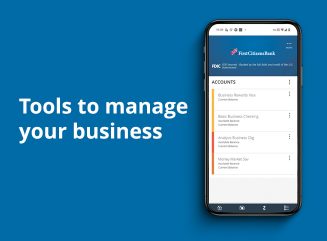Digital banking for business
Seamlessly access all of your accounts from one place with First Citizens Digital Banking for business.

Control your portfolio
Invest how you want, when you want, in real time with Self-Directed Investing.

Digital banking for business
Seamlessly access all of your accounts from one place with First Citizens Digital Banking for business.
See how we're supporting companies
We're committed to serving companies as they expand and succeed. The proof is in our success stories.
Q4 Quarterly Market Review: Available now
The Making Sense team reviews changes in the market during Q4 2025.
A robust business emergency plan can be integral to managing expenses and income during uncertain times. By building a business emergency fund, companies can bolster their ability to thrive in the short and long term.

Unforeseen challenges presented by natural disasters, political unrest, market shifts or unforeseen labor issues can disrupt or even halt operations. It's important to review operations to learn where disruptions can pose a major financial impact. Take care to identify areas that may not be an urgent threat now but could pose an issue if not handled promptly.
Inventory and supplies can be a critical area of concern for manufacturers and producers. For instance, a shift in consumer preferences combined with the impact of a cyclone in the Indian ocean caused the price of vanilla beans to spike almost as high as gold. Businesses of all sizes, from large candy manufacturers to neighborhood bakery shops, felt the impact.
Paying taxes and fees to regulators is an unavoidable cost of doing business. However, sometimes these expenses may be higher than anticipated. Setting aside funds now for potential increases can help mitigate future shocks.
Infrastructure can often be overlooked as a potential emergency area. Utility repairs, plant maintenance and mandatory renovations can be expensive and arise at any time. Companies may be able to put off paying a vendor to dig up a sewer line or rewire a plant, but waiting too long will cause business disruptions and skyrocketing costs.
Business owners may foresee payroll as a major necessity. However, non-payroll human resource costs can easily grow beyond expectations. Consider future benefits growth and project what may happen if a large portion of the staff is suddenly unavailable to work or needs retraining.
Rapid growth can be expensive in the short term and even pose long-term risks if financial preparations aren't in place. The additional costs in labor, training, supply, equipment and space required to ramp up production can put pressure on your cash flow.
Also, staying competitive can require having the means to take advantage of unexpected chances to optimize resources. Suppliers may offer discounts on larger purchases. New technology may emerge to help make operations more efficient. Essential talent may become available for hire. When profit margins are tight, it's even more crucial to be able to respond promptly to these opportunities.
As the old adage goes, plan for the best, but prepare for the worst—readiness hinges upon having sufficient capital available on hand. Companies usually begin the journey of building a fund for their business emergency plan by determining how much capital to set aside and how to generate this capital.
How much you set aside depends on the unique needs of your business. Consider maintaining a readily available portion of annualized revenue, ideally 10% to 30%, or at least 3 to 6 months of expenses.
Prioritizing expenses will help you make sure you have enough in your emergency fund to pay at least your highest-priority bills. Identify the most critical obligations and rank how a lack of coverage will impact operations and revenue. Typically, payroll and suppliers rank high, along with taxes and critical insurance policies.
It's a good practice to continually assess the goal amount as the operations and needs of the business change. Consider saving more during good times. Look for ways to cut costs if the money is amassing quickly enough.
Streamline your savings by automating the process. Once your goal amount is determined, set up automatic transfers into a separate account. Set a specific periodic transfer amount or direct a specified portion of each sales transaction towards the account.
In addition to using savings to build your business emergency fund, consider lining up other financial options for your business emergency plan. First, take advantage of profitable seasons to:
Don't forget about your banking partnership. Work to explore short-term financing options and terms, such as establishing an ample line of credit. Understand how each component of your business emergency plan fits together to suit your needs and strategy to ensure long term survival and growth.



This material is for informational purposes only and is not intended to be an offer, specific investment strategy, recommendation or solicitation to purchase or sell any security or insurance product, and should not be construed as legal, tax or accounting advice. Please consult with your legal or tax advisor regarding the particular facts and circumstances of your situation prior to making any financial decision. While we believe that the information presented is from reliable sources, we do not represent, warrant or guarantee that it is accurate or complete.
Third parties mentioned are not affiliated with First-Citizens Bank & Trust Company.
Links to third-party websites may have a privacy policy different from First Citizens Bank and may provide less security than this website. First Citizens Bank and its affiliates are not responsible for the products, services and content on any third-party website.
First Citizens Bank is a Member FDIC and an Equal Housing Lender icon: sys-ehl.
NMLSR ID 503941

Treasury & Cash Management
Electronic Bill Presentment & Payment
Investment & Retirement Services
Community Association Banking
Equipment Financing & Leasing
Credit Cards
Merchant Services
Email Us
Please select the option that best matches your needs.
Customers with account-related questions who aren't enrolled in Digital Banking or who would prefer to talk with someone can call us directly.